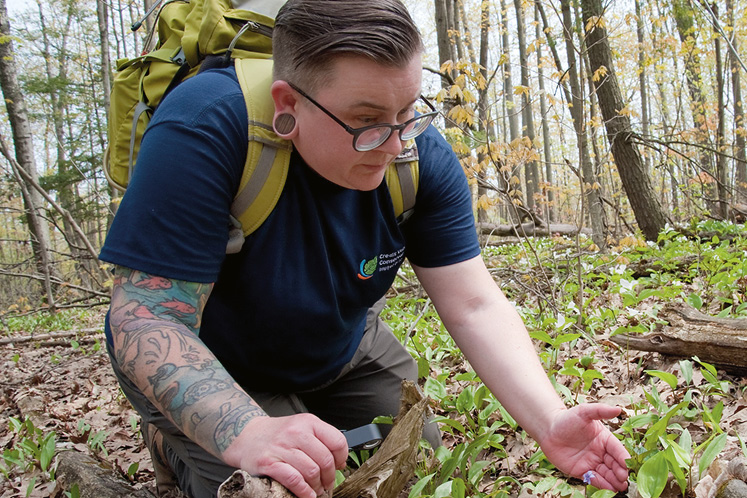Seeing The Forest And The Trees
Field botanist Lisa Riederer painstakingly inventories trees, shrubs and groundcover plants for Credit Valley Conservation.
The Credit River rises around Orangeville and Alton, and flows south to Lake Ontario at Port Credit. The watershed covers 1,000 square kilometres, is home to about 750,000 people and every year provides natural capital – water supply, air purification, waste treatment, soil formation, carbon storage and much more – that experts value at more than $370 million. Its worth, however, extends far beyond dollars when you walk among the trees or paddle in water that has flowed for 10,000 years.
Lisa Riederer is a field botanist who helps maintain the health of this vital landscape. She works for Credit Valley Conservation and spends the growing season creating inventories of plant life in the watershed. “This gives us an understanding of what we have: what’s common, what’s rare, and what invasive species, diseases and pests are impacting the land,” she says.
5:30 a.m. Lisa wakes up and gets a lunch ready. “Usually I make sandwiches, but sometimes just snacks. When it’s really hot I don’t feel like eating much.” She also prepares a one-handed breakfast to eat in the car on the way to the office.
6:30 a.m. She leaves home in Hamilton, where she lives with her partner, Nadia Cavallin, and their two Boston terriers, and heads to the Credit Valley Conservation offices in Mississauga.
7:30 a.m. Lisa arrives at the offices, meets her assistant, Alli Albin, picks up her CVC vehicle and heads for the field. Sometimes it’s an hour’s drive and a 45-minute walk to the worksite, but today’s location is a newly acquired tract near Terra Cotta Conservation Area.
8:10 a.m. After donning boots and hats, the pair pick up backpacks and head out. “We go out into the field with aerial images of the area. We just started using a new field maps app on the phone.” They used to have to use GPS units and a co-ordinate system called a universal transverse mercator to plot their position on the paper map. Now Lisa just presses a button on her phone.
About 1,500 plant species and subspecies grow in the watershed. Lisa identifies which are growing where and Alli takes notes. They also map plant habitats and collect information about their structure.
“I’ll note what trees, shrubs and groundcover plants are present, how tall they are, how much area they cover, and any disturbances affecting the area,” she says. “If the trees are dying, I find out why and make notes on specific wildlife habitat like trees with large cavities, areas producing lots of acorns or nuts, among many other things.”
On this day in May, the black flies are busy, but Lisa doesn’t mind. “After 15 years I don’t notice them, but some days you feel like everything is trying to drink your blood or sting you.” Then there are the days when the humidity makes it feel like more than 40 C, and they’re walking like mountain goats on the steep valley slopes.
“Of course, we do have many good days, but I think the most memorable ones are when we’re doing aquatic surveys. It’s a treat to be out on the water in a kayak, looking at the aquatic edge, recording the plant species growing in lakes and ponds.”
Noon (or whenever the need arises) Lisa and Alli find a fallen log to sit on to have lunch … usually. “It’s a little bit difficult sometimes when you’re wading in a swamp and there’s nothing to sit on. You have a standing lunch.” Kayaks are much more fun, as are the days when a plant takes them by surprise.
Lisa carries a jeweller’s loupe. “When you’re not sure what it is, you can look closely at all the plant features,” she explains. Today, along with trilliums and trout lilies, Lisa finds a plant that is not common in this neck of the woods: wood betony that flowers yellow or pale purple in June.
Surveying an old quarry near Forks of the Credit one day, she found a small depression with some unusual native plants. “There was a sedge that was very rare, with a rare horse tail, and also a plant called smallflower false foxglove – Agalinis paupercula. I had only seen that one in a photo before and obviously it wasn’t anywhere else in the watershed. How would one plant get here?”
Other things can take them by surprise. Over the past few years, bear sightings have been reported in and around the Credit River watershed. One day in the Charles Sauriol Conservation Area, they noticed a lot of bear scat, which made them very wary. “We didn’t see the bear itself, but it had definitely been there a long time.” Earlier on the day we met them, Lisa and Alli had been walking through a rocky area when a turkey vulture suddenly flew up from its nest no more than two metres away. “That scared us! How did we not see it? Turkey vultures are huge.”
The area where they are taking this survey is about 28 hectares (70 acres) and they will need several more days to complete a full inventory. They’ll return twice more, in the summer and again in the fall, to note the plants that thrive in each season. They’re out in the field most weekdays, rain or shine, from mid-May to October, except in thunderstorms and high winds. When the day is very hot, they may start earlier and leave before the heat hits its peak.
In winter and on days when they’re not in the field, Alli enters the data they have collected into the CVC Natural Heritage Database. Lisa will check it and that information becomes part of an extensive database for anyone who needs information about the watershed.
“If someone wants to know how many wetlands we have, they can look to our vegetation community mapping data,” Lisa says. “If someone needs to know what birds are breeding in a certain area, if there are rare species that can be harmed by human activities, how our watershed will be impacted by the next tree pest or disease, our data will help answer those questions.”
3 p.m. Lisa and Alli start their drive back to the CVC offices to check in before heading home.
Related Stories

Tree Talk
Mar 20, 2023 | | Country Living 101No matter what your goal – adding shade and beauty to your property, attracting wildlife or fighting climate change – planting more trees is a good idea.

Nature Booster: Janice McClelland
Nov 29, 2021 | | Local HeroesHow the Erin resident transformed a passion for the outdoors into many fruitful years of volunteering for the Bruce Trail Conservancy.









